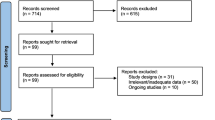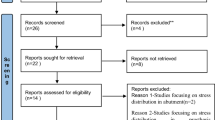Abstract
Purpose
To evaluate the performance of complete-arch implant-supported fixed dental prostheses (FDPs) fabricated with polyetheretherketone (PEEK) and polyetherketoneketone (PEKK) framework in clinical cases.
Materials and methods
This systematic review followed the guidelines of Preferred Reporting Items for Systematic Reviews and Meta-Analyses and was registered in the International Prospective Register of Systematic Reviews with the number CRD42023399494. The electronic database PubMed, Cochrane Library and EBSCOhost were assessed for clinical research and reports on complete-arch implant-supported FDPs fabricated with PEEK and PEKK framework. Human studies with a minimum follow-up of 1 year and published in an English language were the only ones included.
Results
The initial database and hand search provided 564 articles. Finally, 12 articles published between 2018 and 2022 were included in this systematic review. The mean follow-up ranged from 1 year to 6 years. The included studies reported 119 (114 PEEK, 5 PEKK) complete-arch implant-supported FDPs during 1 year follow-up. The cumulative survival rate of prostheses with PEEK as a framework was 97.3%. Prostheses fractures and complications were found with both PEEK and PEKK frameworks. No implant failure reported with both PEEK and PEKK prostheses.
Conclusion
In short-term follow-up, the complete-arch implant-supported FDPs with PEEK as a framework showed a good survival rate and acceptable health of the supporting tissues. The PEEK framework had shown adhesion issues as the most common prosthetic complication. Limited data were available on PEKK as framework material, so further long-term clinical trials are required.
This is a preview of subscription content, access via your institution
Access options
Subscribe to this journal
Receive 4 print issues and online access
$259.00 per year
only $64.75 per issue
Buy this article
- Purchase on Springer Link
- Instant access to full article PDF
Prices may be subject to local taxes which are calculated during checkout

Similar content being viewed by others
References
Gallardo YNR, da Silva-Olivio IR, Gonzaga L, Sesma N, Martin W. A systematic review of clinical outcomes on patients rehabilitated with complete-arch fixed implant-supported prostheses according to the time of loading. J Prosthodont. 2019;28:958–68.
Rohlin M, Nilner K, Davidson T, Gynther G, Hultin M, Jemt T, et al. Treatment of adult patients with edentulous arches: a systematic review. Int J Prosthodont. 2012;25:553–67.
Cracel-Lopes JL, Matos-Garrido N, Jiménez-Guerra A, Ortiz-Garcia I, Moreno-Muñoz J, Núñez-Márquez E, et al. Immediate functional loading with full-arch fixed implant-retained rehabilitation in periodontal patients: clinical study. Int J Environ Res Public Health. 2022;19:13162.
Malo´ P, de Araújo Nobre M, Lopes A, Ferro A, Gravito I. All-on-4® treatment concept for the rehabilitation of the completely edentulous mandible: a 7-year clinical and 5-year radiographic retrospective case series with risk assessment for implant failure and marginal bone level. Clin Implant Dent Relat Res. 2015;17(suppl 2):e531–41.
Ali K, Kay EJ. What are the long-term survival and complication rates of complete-arch fixed implant rehabilitation in edentulous patients? Evid Based Dent. 2019;20:97–8.
Skalak R. Biomechanical considerations in osseointegrated prostheses. J Prosthet Dent. 1983;49:843–8.
Kwon T, Bain PA, Levin L. Systematic review of short- (5-10 years) and long term (10 years or more) survival and success of full-arch fixed dental hybrid prostheses and supporting implants. J Dent. 2014;42:1228–41.
Fischer K, Stenberg T. Prospective 10-year cohort study based on a randomized, controlled trial (RCT) on implant-supported full-arch maxillary prostheses. part II: prosthetic outcomes and maintenance. Clin Implant Dent Relat Res. 2013;15:498–508.
Mertens C, Steveling HG. Implant-supported fixed prostheses in the edentulous maxilla: 8-year prospective results. Clin Oral Implants Res. 2011;22:464–72.
Malo´ P, Nobre MDE, Lopes A. The rehabilitation of completely edentulous maxillae with different degrees of resorption with four or more immediately loaded implants: a 5-year retrospective study and a new classification. European J Oral Implantol. 2011;4:227–43.
Purcell BA, Mc Glumphy EA, Holloway JA, Beck FM. Prosthetic complications in mandibular metal-resin implant-fixed complete dental prostheses: a 5- to 9-year analysis. Int J Oral Maxillofac Implants. 2008;23:847–57.
Ortorp A, Jemt T. Early laser-welded titanium frameworks supported by implants in the edentulous mandible: a 15- year comparative follow-up study. Clin Implant Dent Relat Res. 2009;11:311–22.
Wong CCK, Narvekar U, Petridis H. Prosthodontic complications of metal-ceramic and all-ceramic, completearch fixed implant prostheses with minimum 5 years mean follow-up period. a systematic review and meta-analysis. J Prosthodont. 2019;28:e722–35.
Mangano F, Macchi A, Caprioglio A, Sammons RL, Piattelli A, Mangano C. Survival and complication rates of fixed restorations supported by locking-taper implants: A prospective study with 1 to 10 years of follow-up. J Prosthodont. 2014;23:434–44.
Gonzalez-Gonzalez I, de Llanos-Lanchares H, Brizuela-Velasco A, Alvarez-Riesgo JA, Llorente-Pendas S, Herrero-Climent M. Complications of fixed full-arch implant-supported metal-ceramic prostheses. Int J Environ Res Public Health. 2020;17:4250.
Bidra AS, Rungruanganunt P, Gauthier M. Clinical outcomes of full arch fixed implant-supported zirconia prostheses: A systematic review. Eur J Oral Implantol. 2017;10(Suppl 1):35–45.
Tischler M, Patch C, Bidra AS. Rehabilitation of edentulous jaws with zirconia complete-arch fixed implantsupported prostheses: An up to 4-year retrospective clinical study. J Prosthet Dent. 2018;120:204–9.
Abdulmajeed AA, Lim KG, Närhi TO, Cooper LF. Complete-arch implant-supported monolithic zirconia fixed dental prostheses: A systematic review. J Prosthet Dent. 2016;115:672–7.
Oliva J, Oliva X, Oliva JD. All-on-three delayed implant loading concept for the completely edentulous maxilla and mandible: a retrospective 5-year follow-up study. Int J Oral Maxillofac Implants. 2012;27:1584–92.
Drago C, Gurney L. Maintenance of implant hybrid prostheses: clinical and laboratory procedures. J Prosthodont. 2013;22:28–35.
Drago C, Howell K. Concepts for designing and fabricating metal implant frameworks for hybrid implant prostheses. J Prosthodont. 2012;21:413–24.
Maló P, de Araújo NM, Borges J, Almeida R. Retrievable metal ceramic implant-supported fixed prostheses with milled titanium frameworks and all-ceramic crowns: retrospective clinical study with up to 10 years of follow-up. J Prosthodont. 2012;21:256–64.
Paratelli A, Perrone G, Ortega R, Gómez-Polo M. Polyetheretherketone in implant prosthodontics: A scoping review. Int J Prosthodont. 2020;33:671–9. https://doi.org/10.1038/s41432-023-00928-x
Dawson JH, Hyde B, Hurst M, Harris BT, Lin WS. Polyetherketoneketone (PEKK), a framework material for complete fixed and removable dental prostheses: A clinical report. J Prosthet Dent. 2018;119:867–72.
Preis V, Hahnel S, Behr M, Bein L, Rosentritt M. In-vitro fatigue and fracture testing of CAD/CAM-materials in implant-supported molar crowns. Dent Mater. 2017;33:427–33.
Zoidis P, Bakiri E, Papathanasiou I, Zappi A. Modified PEEK as an alternative crown framework material for weak abutment teeth: a case report. Gen Dent. 2017;65:37–40.
Fuhrmann G, Steiner M, Freitag-Wolf S, Kern M. Resin bonding to three types of polyaryletherketones (PAEKs)- durability and influence of surface conditioning. Dent Mater. 2014;30:357–63.
Han KH, Lee JY, Shin SW. Implant- and tooth-supported fixed prostheses using a high-performance polymer (Pekkton) framework. Int J Prosthodont. 2016;29:451–4.
Menini M, Conserva E, Tealdo T, Bevilacqua M, Pera F, Ravera G, et al. The use of a masticatory robot to analyze the shock absorption capacity of different restorative materials for implant prosthesis. J Biol Res. 2011;84:118–9.
Conserva E, Menini M, Tealdo T, Bevilacqua M, Ravera G, Pera F, et al. The use of a masticatory robot to analyze the shock absorption capacity of different restorative materials for prosthetic implants: a preliminary report. Int J Prosthodont. 2009;22:53–5. 30
Bidez MW, Misch CF. Force transfer in implant dentistry: Basic concepts and principles. J. Oral Implantol. 1992;18:264–74.
Rosentritt M, Schneider-Feyrer S, Behr M, Preis V. In vitro shock absorption tests on implant-supported crowns: influence of crown materials and luting agents. Int J Oral Maxillofac Implants. 2017;33:116–22.
Wang J, Wu P, Liu HI, Zhang L, Liu LP, Ma CF, et al. Polyetheretherketone versus titanium CAD-CAM framework for implant-supported fixed complete dentures: a retrospective study with up to 5-year follow-up. J Prosthodont Res. 2022;66:279–87.
Zoidis P. The all-on-4 modified polyetheretherketone treatment approach: A clinical report. J Prosthet Dent. 2018;119:516–21.
Al-Rabab'ah M, Hamadneh W, Alsalem I, Khraisat A, Karaky AA. Use of high performance polymers as dental implant abutments and frameworks: a case series report. J Prosthodont. 2019;28:365–72.
Page MJ, McKenzie JE, Bossuyt PM, Boutron I, Hoffmann TC, Mulrow CD, et al. The PRISMA 2020 statement: an updated guideline for reporting systematic reviews. BMJ. 2021;372:n71.
Higgins JPT, Thomas J, Chandler J, Cumpston M, Li T, Page MJ, et al. Cochrane Handbook for Systematic Reviews of Interventions. 2nd ed. Chichester: John Wiley & Sons; 2019. p. 633–49.
Stone PW. Popping the (PICO) question in research and evidence-based practice. Appl Nurs Res. 2002;15:197–8.
Jokstad A, Braegger U, Brunski JB, Carr AB, Naert I, Wennerberg A. Quality of dental implants. Int Dent J. 2003;53(6 suppl 2):409–43.
Higgins JPT, Altman GD, Gøtzsche PC, Jüni P, Moher D, Oxman AD, et al. The Cochrane Collaboration’s tool for assessing risk of bias in randomised trials. BMJ. 2011;343:d5928.
Dawson JH, Dix G, Harris BT, Lin WS. Importance of prototype use for implant-supported complete fixed dental prosthesis (ICFDP). Compend Contin Educ Dent. 2018;39:e5–e8.
Kwan JC, Kwan N. Clinical application of peek as a provisional fixed dental prosthesis retained by reciprocated guide surfaces of healing abutments during dental implant treatment. Int J Oral Maxillofac Implants. 2021;36:581–6.
Maló P, de Araújo Nobre M, Moura Guedes C, Almeida R, Silva A, Sereno N, et al. Short-term report of an ongoing prospective cohort study evaluating the outcome of full-arch implant supported fixed hybrid polyetheretherketone-acrylic resin prostheses and the All-on-Four concept. Clin Implant Dent Relat Res. 2018;20:692–702.
Oh KC, Park JH, Lee JH, Moon HS. Treatment of a mandibular discontinuity defect by using a fibula free flap and an implant-supported fixed complete denture fabricated with a PEKK framework: A clinical report. J Prosthet Dent. 2018;119:1021–24.
Cabello-Domínguez G, Pérez-López J, Veiga-López B, González D, Revilla-León M. Maxillary zirconia and mandibular composite resin-lithium disilicate-modified PEEK fixed implant-supported restorations for a completely edentulous patient with an atrophic maxilla and mandible: A clinical report. J Prosthet Dent. 2020;124:403–10.
de Araújo Nobre M, Guedes CM, Almeida R, Silva A, Sereno N. Hybrid polyetheretherketone (PEEK)-acrylic resin prostheses and the all-on-4 concept: a full-arch implant-supported fixed solution with 3 years of follow-up. J Clin Med. 2020;9:2187. https://doi.org/10.1038/s41432-023-00928-x
Moustafa Ali RM, Helmy MHE-D. Poly ether-ether ketone veneered with composite versus porcelain fused to metal full arch fixed screw retained prosthesis for atrophied mandibular ridges. One year randomized clinical and radiographic trial study. Egypt Dent J. 2020;66:2439–49.
Montero J, Guadilla Y, Flores J, Pardal-Peláez B, Quispe-López N, Gómez-Polo C, et al. Patient-centered treatment outcomes with full-arch peek rehabilitation supported on four immediate or conventionally loaded implants. a randomized clinical trial. J Clin Med. 2021;10:4589.
Jung BY, Park WS, Woo CW, Jeong SA, Jung BY. Zirconia-veneered polyetherketoneketone frameworks of implant-supported complete arch fixed dental prostheses: A report on 5 patients. J Prosthet Dent. 2022;S0022- 3913(22):00497–8.
Kortam SA, ELsyad MA, Awad SS, ElHelbawy NE. Metal-ceramic and polyether ether ketone-composite maxillary fixed prosthesis supported by four implants and opposed by removable distal extension partial dentures: a comparative study of clinical and prosthetic outcomes. Int J Oral Maxillofac Implants. 2022;37:181–9.
Mourad KE, Altonbary GY, Emera RMK, Hegazy SAF. Polyetheretherketone computer-aided design and computer-aided manufacturing framework for all-on-four mandibular full-arch prosthesis: 3 Years' retrospective study of peri-implant soft tissue changes and ridge base relationship. J Prosthodont 2022 Sep 7. https://doi.org/10.1111/jopr.13602. Online ahead of print
Wang J, Gu JT, Meng M, Wang CY, Chen JH, Niu LN. Polyetheretherketone framework for implant-supported full-arch fixed dental prostheses in a periodontitis patient with a 6-year follow-up: a case report. Chin J Dent Res. 2022;25:149–58.
Stawarczyk B, Beuer F, Wimmer T, Jahn D, Sener B, Roos M, et al. Polyetheretherketone- A suitable material for fixed dental prostheses? J. Biomed Mater Res B Appl Biomater. 2013;101:1209–16.
Calderon PDS, Kogawa EM, Lauris JR, Conti PC. The influence of gender and bruxism on the human maximum bite force. J Appl Oral Sci. 2006;14:448–53.
Nishigawa K, Bando E, Nakano M. Quantitative study of bite force during sleep associated bruxism. J Oral Rehabil. 2001;28:485–91.
Ji S, Sun C, Zhao J, Liang F. Comparison and analysis on mechanical property and machinability about polyetheretherketone and carbon-fibers reinforced polyetheretherketone. Materials (Basel). 2015;8:4118–30.
Lee KS, Shin SW, Lee SP, Kim JE, Kim JH, Lee JY. Comparative evaluation of a four implant-supported polyetherketoneketone framework prosthesis: a three-dimensional finite element analysis based on cone beam computed tomography and computer-aided design. Int J Prosthodont. 2017;30:581–5.
Villefort RF, Diamantino PJS, Zeidler S, Borges ALS, Silva-Concílio LR, Saavedra G, et al. Mechanical response of pekk and peek as frameworks for implant-supported full-arch fixed dental prosthesis: 3D finite element analysis. Eur J Dent. 2022;16:115–21.
Bacchi A, Consani RL, Masquita MF, Dos, Santos MB. Effect of framework material and vertical misfit on stress distribution in implant-supported partial prosthesis under load application: 3-D finite element analysis. Acta Odontol Scand. 2013;71:1243–9.
Amelya A, Kim JE, Woo CW, Otgonbold J, Lee KW. Load-Bearing Capacity of Posterior CAD-CAM Implant- Supported Fixed Partial Dentures Fabricated with Different Esthetic Materials. Int J Prosthodont. 2019;32:201–4.
Guess PC, Schultheis S, Bonfante EA, Coelho PG, Ferencz JL, Silva NR. All ceramic systems: laboratory and clinical performance. Dent Clin North Am. 2011;55:333–52.
Stawarczyk B, Thrun H, Eichberger M, Roos M, Edelhoff D, Schweiger J, et al. Effect of different surface pretreatments and adhesives on the load-bearing capacity of veneered 3-unit PEEK FDPs. J Prosthet Dent. 2015;114:666–73.
Stawarczyk B, Jordan P, Schmidlin PR, Roos M, Eichberger M, Gernet W, et al. PEEK surface treatment effects on tensile bond strength to veneering resins. J Prosthet Dent. 2014;112:1278–88.
Keul C, Liebermann A, Schmidlin PR, Roos M, Sener B, Stawarczyk B. Influence of PEEK surface modification on surface properties and bond strength to veneering resin composites. J Adhes Dent. 2014;16:383–92.
Miyagaki A, Kamaya Y, Matsumoto T, Honda K, Shibahara, Hongo C, et al. Surface modification of poly(ether ether ketone) through Friedel-Crafts reaction for high adhesion strength. Langmuir. 2019;35:9761–8.
Gama LT, Duque TM, Özcan M, Philippi AG, Mezzomo LAM, Gonçalves TMSV. Adhesion to high-performance polymers applied in dentistry: A systematic review. Dent Mater. 2020;36:e93–e108.
Hahnel S, Wieser A, Lang R, Rosentritt M. Biofilm formation on the surface of modern implant abutment materials. Clin Oral Implants Res. 2015;26:1297–301.
Sturz CR, Faber FJ, Scheer M, Rothamel D, Neugebauer J. Effects of various chair-side surface treatment methods on dental restorative materials with respect to contact angles and surface roughness. Dent Mater J. 2015;34:796–813. https://doi.org/10.1038/s41432-023-00928-x
Wachtel A, Zimmermann T, Sutel M, Adali U, Abou-Emara M, Muller WD, et al. Bacterial leakage and bending moments of screw-retained, composite-veneered PEEK implant crowns. J Mech Behav Biomed Mater. 2019;91:32–7.
Liao C, Li Y, Tjong SC. Polyetheretherketone and its composites for bone replacement and regeneration. Polymers (Basel). 2020;12:2858.
Stawarczyk B, Eichberger M, Uhrenbacher J, Wimmer T, Edelhoff D, Schmidlin PR. Three-unit reinforced polyetheretherketone composite FDPs: influence of fabrication method on load-bearing capacity and failure types. Dent Mater J. 2015;34:7–12.
Alqurashi H, Khurshid Z, Syed AUY, Rashid Habib S, Rokaya D, Zafar MS. Polyetherketoneketone (PEKK): An emerging biomaterial for oral implants and dental prostheses. J Adv Res. 2021;28:87–95.
Author information
Authors and Affiliations
Contributions
SKM: concept/ design, data collection, data analysis/ interpretation, drafting article, critical revision of article, approval of article. SRB: interpretation, drafting article, critical revision of article, approval of article. RC: drafting article, critical revision of article, approval of article.
Corresponding author
Ethics declarations
Competing interests
The authors declare no competing interests.
Additional information
Publisher’s note Springer Nature remains neutral with regard to jurisdictional claims in published maps and institutional affiliations.
Rights and permissions
Springer Nature or its licensor (e.g. a society or other partner) holds exclusive rights to this article under a publishing agreement with the author(s) or other rightsholder(s); author self-archiving of the accepted manuscript version of this article is solely governed by the terms of such publishing agreement and applicable law.
About this article
Cite this article
Mishra, S.K., Bhasmey, S.R. & Chowdhary, R. Complete-arch implant-supported fixed dental prostheses fabricated with PEEK and PEKK framework: a systematic review. Evid Based Dent 24, 193 (2023). https://doi.org/10.1038/s41432-023-00928-x
Received:
Accepted:
Published:
Issue Date:
DOI: https://doi.org/10.1038/s41432-023-00928-x
This article is cited by
-
Complete-arch implant-supported fixed dental prostheses fabricated with PEEK and PEKK framework: a systematic review
Evidence-Based Dentistry (2023)



